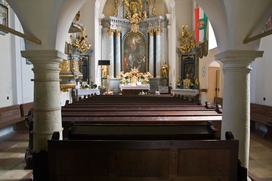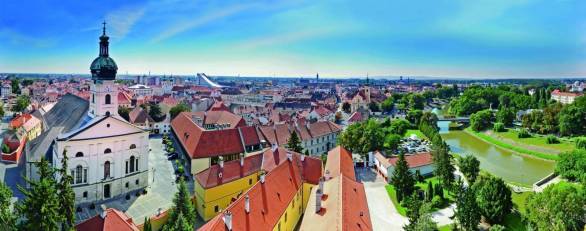Church of Our Lord’s Ascension
György Széchényi Bishop of Győr had the old church demolished as well as rebuilt and expanded in 1662. He also had the building restored after it was destroyed by the Turks retreating from Vienna in 1683.
The church with its ornate tower with a stone-balustraded balcony gained its present form in 1777. Its high altar, side altars, pulpit and Rococo pews were also created at that time. The two defining elements of the structure behind the main altar reflect the two consecrated names of the church, “dedicated to the name of St Nicholas and Our Lord’s Ascension”. These are the gilded statue of the eponymous bishop above it and the painting depicting Jesus ascending to heaven below it. The monumental composition also includes the Zichy coat-of-arms above the picture as well as the statues of King St Stephen and St Emeric standing guard on both sides. The altar itself is comprised of entirely gold-clad carving: the tabernacle door is a relief depicting Abraham’s sacrifice of his son, the angels and the Lamb sitting on the seven-sealed book. The pulpit’s reliefs, also gilded, depict the baptism of Jesus, the selection of the apostles and the scene of the Sermon on the Mount. There is a small statue of Jesus and John the Baptist on the cover of the 17th-century painted stone baptismal font. The five-piece Baroque organ was donated by Bishop Christian August of Saxe-Zeitz (the first prince-primate of Hungary). There is a Baroque painting depicting the coronation of the Virgin Mary and the Trinity on the side wall of the sanctuary. A picture of St Cayetan giving thanks for the end of the plague hangs below the window on the north wall. As well as this popular saint of the time, the work also includes a German-language prayer and the exact date (7 December 1713). The plaques above the Stations of the Cross invoke Jesus’s memorable meals: the first is the wedding at Cana, the second the feast in the house of Simon the Pharisee, the third the Last Supper and the fourth picture the moment of breaking bread that opened the eyes of the disciples in Emmaus.

